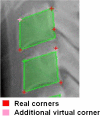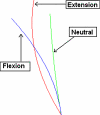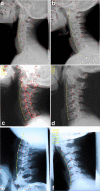Spine localization in X-ray images using interest point detection
- PMID: 18273669
- PMCID: PMC3043695
- DOI: 10.1007/s10278-007-9099-3
Spine localization in X-ray images using interest point detection
Abstract
This study was conducted to evaluate a new method used to calculate vertebra orientation in medical x-ray images. The goal of this work is to develop an x-ray image segmentation approach used to identify the location and the orientation of the cervical vertebrae in medical images. We propose a method for localization of vertebrae by extracting the anterior-left-faces of vertebra contours. This approach is based on automatic corner points of interest detection. For this task, we use the Harris corner detector. The final goal is to determine vertebral motion induced by their movement between two or several positions. The proposed system proceeds in several phases as follows: (a) image acquisition, (b) corner detection, (c) extracting of the corners belonging to vertebra left sides, (d) global estimation of the spine curvature, and (e) anterior face vertebra detection.
Figures











Similar articles
-
Vertebra identification using template matching modelmp and K-means clustering.Int J Comput Assist Radiol Surg. 2014 Mar;9(2):177-87. doi: 10.1007/s11548-013-0927-2. Epub 2013 Jul 24. Int J Comput Assist Radiol Surg. 2014. PMID: 23881250 Review.
-
Spine localization and vertebral mobility analysis using faces contours detection.Annu Int Conf IEEE Eng Med Biol Soc. 2007;2007:6558-61. doi: 10.1109/IEMBS.2007.4353862. Annu Int Conf IEEE Eng Med Biol Soc. 2007. PMID: 18003528
-
VolHOG: a volumetric object recognition approach based on bivariate histograms of oriented gradients for vertebra detection in cervical spine MRI.Med Phys. 2014 Aug;41(8):082305. doi: 10.1118/1.4890587. Med Phys. 2014. PMID: 25086554
-
Automatic estimation of orientation and position of spine in digitized X-rays using mathematical morphology.J Digit Imaging. 2005 Sep;18(3):234-41. doi: 10.1007/s10278-005-5150-4. J Digit Imaging. 2005. PMID: 15924275 Free PMC article.
-
Line drawing analyses of static cervical X ray used in chiropractic.J Manipulative Physiol Ther. 1992 Sep;15(7):442-9. J Manipulative Physiol Ther. 1992. PMID: 1431632 Review.
Cited by
-
Vertebra identification using template matching modelmp and K-means clustering.Int J Comput Assist Radiol Surg. 2014 Mar;9(2):177-87. doi: 10.1007/s11548-013-0927-2. Epub 2013 Jul 24. Int J Comput Assist Radiol Surg. 2014. PMID: 23881250 Review.
-
Evaluation of U-Net models in automated cervical spine and cranial bone segmentation using X-ray images for traumatic atlanto-occipital dislocation diagnosis.Sci Rep. 2022 Dec 12;12(1):21438. doi: 10.1038/s41598-022-23863-w. Sci Rep. 2022. PMID: 36509842 Free PMC article.
-
A framework of vertebra segmentation using the active shape model-based approach.Int J Biomed Imaging. 2011;2011:621905. doi: 10.1155/2011/621905. Epub 2011 Jul 31. Int J Biomed Imaging. 2011. PMID: 21826134 Free PMC article.
-
Image Segmentation and Analysis of Flexion-Extension Radiographs of Cervical Spines.J Med Eng. 2014;2014:976323. doi: 10.1155/2014/976323. Epub 2014 Oct 13. J Med Eng. 2014. PMID: 27006937 Free PMC article.
-
AM-UNet: automated mini 3D end-to-end U-net based network for brain claustrum segmentation.Multimed Tools Appl. 2022;81(25):36171-36194. doi: 10.1007/s11042-021-11568-7. Epub 2022 Jan 8. Multimed Tools Appl. 2022. PMID: 35035265 Free PMC article.
References
-
- Xu X, Lee D, Antani S: Localizing contour points for indexing an x-ray image retrieval system (2003) Proceedings of the 16th IEEE Symposium on Computer-based Medical Systems. New York, NY, 2627 June 2003, pp 169–174
-
- Rico G, Benjelloun M, Libert G: Detection, localization and representation of cervical vertebrae. Proceedings of the Computer Vision Winter Workshop 2001; Bled, Slovenia, February 2001, pp 114–124
-
- Benjelloun M, Tellez H, Mahmoudi S: Vertebra edge detection using polar signature. In: Proceedings of the 18th International Conference on Pattern Recognition (ICPR2006). Vol. 1, pp 476–479
-
- Kass M, Witkin A, Terzopoulos D. Snakes: active contour models. Int J Comput Vis. 1987;1:321–331. doi: 10.1007/BF00133570. - DOI
Publication types
MeSH terms
LinkOut - more resources
Full Text Sources
Other Literature Sources
Medical

